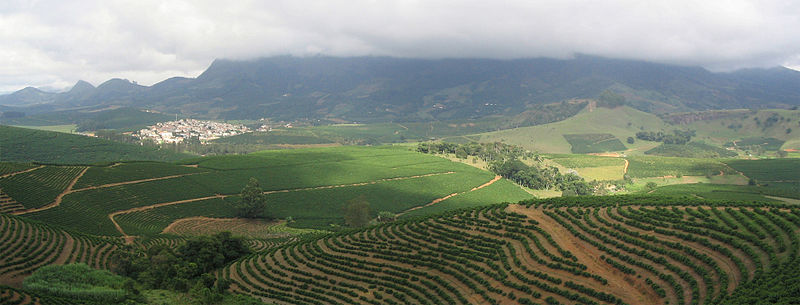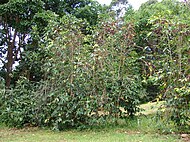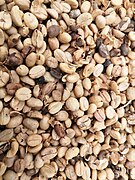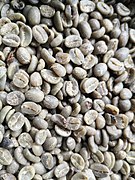Coffea arabica
| Coffea arabica | |
|---|---|
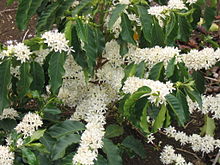
| |
| Coffea arabica flowers | |

| |
| Coffea arabica fruit | |
| Scientific classification | |
| Kingdom: | Plantae |
| Clade: | Tracheophytes |
| Clade: | Angiosperms |
| Clade: | Eudicots |
| Clade: | Asterids |
| Order: | Gentianales |
| Family: | Rubiaceae |
| Genus: | Coffea |
| Species: | C. arabica
|
| Binomial name | |
| Coffea arabica | |
Coffea arabica (/əˈræbɪkə/), also known as the Arabica coffee, is a species of flowering plant in the coffee and madder family Rubiaceae. It is believed to be the first species of coffee to have been cultivated and is the dominant cultivar, representing about 60% of global production.[2] Coffee produced from the less acidic, more bitter, and more highly caffeinated robusta bean (C. canephora) makes up most of the remaining coffee production. The natural populations of Coffea arabica are restricted to the forests of South Ethiopia and Yemen.[3][4]
Taxonomy
Coffea arabica was first described scientifically by Antoine de Jussieu, who named it Jasminum arabicum after studying a specimen from the Botanic Gardens of Amsterdam. Linnaeus placed it in its own genus Coffea in 1737.[5]
Coffea arabica is one of the
Description
Wild plants grow between 9 and 12 m (30 and 39 ft) tall, and have an open branching system; the leaves are opposite, simple elliptic-ovate to oblong, 6–12 cm (2.5–4.5 in) long and 4–8 cm (1.5–3 in) broad, glossy dark green. The flowers are white, 10–15 mm in diameter, and grow in axillary clusters. The seeds are contained in a drupe (commonly called a "cherry") 10–15 mm in diameter, maturing bright red to purple and typically containing two seeds, often called coffee beans.
Distribution and habitat
Endemic to the southwestern
The coffee tree was first brought to
Coffee has been produced in Queensland and New South Wales of Australia, starting in the 1980s and 90s.[17] The Wet Tropics Management Authority has classified Coffea arabica as an environmental weed for southeast Queensland due to its invasiveness in non-agricultural areas.[18][19]
History
The first written record of coffee made from
Cultivation and use
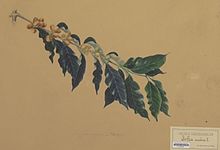
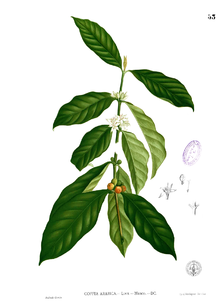
Coffea arabica accounts for 60% of the world's coffee production.[2][21]
C. arabica takes approximately seven years to mature fully, and it does best with 1.0–1.5 metres (39–59 in) of rain, evenly distributed throughout the year.[citation needed] It is usually cultivated at an altitude between 1,300 and 1,500 m (4,300 and 4,900 ft),[citation needed] but there are plantations that grow it as low as sea level and as high as 2,800 m (9,200 ft).[22]
The plant can tolerate low temperatures, but not frost, and it does best with an average temperature between 15 and 24 °C (59 and 75 °F).[23] Commercial cultivars mostly only grow to about 5 m, and are frequently trimmed as low as 2 m to facilitate harvesting. Unlike Coffea canephora, C. arabica prefers to be grown in light shade.[24]
Two to four years after planting, C. arabica produces small, white, highly fragrant flowers. The sweet fragrance resembles the sweet smell of jasmine flowers. Flowers opening on sunny days result in the greatest number of berries. This can be problematic and deleterious, however, as coffee plants tend to produce too many berries; this can lead to an inferior harvest and even damage yield in the following years, as the plant will favor the ripening of berries to the detriment of its own health.
On well-kept plantations, overflowering is prevented by pruning the tree. The flowers only last a few days, leaving behind only the thick, dark-green leaves. The berries then begin to appear. These are as dark green as the foliage until they begin to ripen, at first to yellow and then light red and finally darkening to a glossy, deep red. At this point, they are called "cherries", which fruit they then resemble, and are ready for picking.
The berries are oblong and about 1 cm long. Inferior coffee results from picking them too early or too late, so many are picked by hand to be able to better select them, as they do not all ripen at the same time. They are sometimes shaken off the tree onto mats, which means ripe and unripe berries are collected together.
The trees are difficult to cultivate and each tree can produce from 0.5 to 5.0 kilograms (1.1 to 11.0 lb) of dried beans, depending on the tree's individual character and the climate that season. The most valuable part of this cash crop is the beans inside. Each berry holds two locules containing the beans. The coffee beans are actually two seeds within the fruit; sometimes, a third seed or one seed, a peaberry, grows in the fruit at the tips of the branches. These seeds are covered in two membranes; the outer one is called the "parchment coat" and the inner one is called the "silver skin".
On
It is expected that a medium-term depletion of indigenous populations of C. arabica may occur, due to projected
Gourmet coffees are almost exclusively high-quality mild varieties of arabica coffee, and among the best known arabica coffee beans in the world are those from
Blends consisting only of Arabica are often labelled "100% Arabica" as a sign of quality. In 2023, several large coffee roasters dropped the "100% Arabica" declaration previously residing on some of their packages and started to blend less expensive
Strains
One strain of Coffea arabica naturally contains very little caffeine. While beans of normal C. arabica plants contain 12 mg of caffeine per gram of dry mass, these mutants contain only 0.76 mg of caffeine per gram, but with a taste similar to normal coffee.[31]
Threats
Although it has a huge wild population of 13.5 to 19.5 billion individuals throughout its native range, C. arabica is still considered
The conservation of the genetic variation of C. arabica relies on conserving healthy populations of wild coffee in the
Climate change also serves as a threat to cultivated C. arabica due to their temperature sensitivity, and some studies estimate that by 2050, over half of the land used for cultivating coffee could be unproductive. The more heat-tolerant Coffea stenophylla may replace C. arabica as the dominant coffee species in cultivation in order to guard against this.[34]
Gallery
-
Coffee germinating.
-
Coffee flowers.
-
Fresh coffee fruits.
-
Fresh coffee seeds ("beans").
-
Fermented coffee seeds.
-
Fermented coffee (green) seeds without hulls.
-
Fermented and roasted coffee seeds.
-
Unroasted ("green") coffee (Coffea arabica) seeds from Brazil.
See also
References
- . Retrieved 19 November 2021.
- ^ a b "Coffee: World Markets and Trade" (PDF). United States Department of Agriculture – Foreign Agricultural Service. 16 June 2017. Archived from the original (PDF) on 8 December 2017. Retrieved 8 December 2017 – via Cornell University.
- ^ Meyer, Frederick G. 1965. Notes on wild Coffea arabica from Southwestern Ethiopia, with some historical considerations. Economic Botany 19: 136–151.
- ISBN 978-0-12-370371-2.
- ISBN 978-0-7099-0787-9.
- S2CID 7978085.
- S2CID 234481707.)
{{cite journal}}: CS1 maint: multiple names: authors list (link - .
- ^ ISBN 9780896802476. Retrieved 26 January 2016.
- ISBN 978-1-78472-429-0.
- ^ Charrier & Berthaud (1985), p. 20.
- ^ .
- ^ Kew World Checklist of Selected Plant Families, Coffea arabica
- ^ a b Hargreaves, Dorothy; Hargreaves, Bob (1964). Tropical Trees of Hawaii. Kailua, Hawaii: Hargreaves. p. 17.
- ^ "Coffea arabica (PIER species info)". Archived from the original on 21 October 2012. Retrieved 15 July 2011.
- ^ Nyanatusita, Bhikkhu; Dissanayake, Rajith (2013). "Udawattakele: 'A Sanctuary Destroyed From Within'" (PDF). Loris, Journal of the Wildlife and Nature Protection Society of Sri Lanka. 26 (5 & 6): 44.
- ^ "Coffee". AgriFutures Australia. Retrieved 2 September 2022.
- ^ Cripps, Sally (21 September 2015). "Coffee eradication wins weed award". Queensland Country Life.
- ^ Batianoff, George N.; Butler, Don W. (2002). "Assessment of invasive naturalized plants in south-east Queensland" (PDF). Plant Protection Quarterly. 17 (1): 27–34.
- ISBN 0-7103-1034-X
- ^ Marchant, Andrew (4 February 2023). "Intro to Arabica Coffee - Is 100% Arabica the Best Coffee?". Make Espresso. Archived from the original on 1 March 2023. Retrieved 1 March 2023.
- ISBN 978-3-86727-043-4.
- ISBN 978-3-86727-990-1.
- PMID 31089179.
- ^ "Coffee: The World in Your Cup." Seattle, WA: Burke Museum at the University of Washington.
- PMID 23144840.
- S2CID 17384126.
- ^ "Os melhores grãos do mundo". Revista Veja (in Portuguese). Editora Abril. 31 July 2008. Archived from the original on 5 August 2008. Retrieved 29 July 2008. Edition 2071. Print edition p. 140
- ^ Fussell, Betty (5 September 1999). "The World Before Starbucks". The New York Times. Retrieved 29 July 2008.
- ^ Fabricant, Florence (2 September 1992). "Americans Wake Up and Smell the Coffee". The New York Times. Retrieved 29 July 2008.
- S2CID 4428420.
- S2CID 4428420.
- PMID 25314878.
- ^ "Climate change: Future-proofing coffee in a warming world". BBC News. 19 April 2021. Retrieved 24 April 2021.
Further reading
- Silvarolla, Maria B.; Mazzafera, Paulo; Fazuoli, Luiz C. (2004). "A naturally decaffeinated arabica coffee". S2CID 4428420.
- Weinberg, Bennet Alan; Bealer, Bonnie K. (2001). The World of Caffeine: The Science and Culture of the World's Most Popular Drug. New York: Routledge. ISBN 978-0-415-92722-2.
External links



